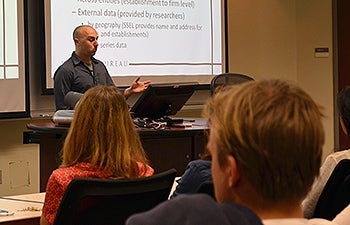Rare Access to Census Data
Seeking economic and demographic data for her sociology research, Rachelle Wang knows the value of restricted information from the U.S. Census Bureau.
“Up-to-date quantitative and qualitative data is imperative for my research in family studies,” said Wang, a USC Dornsife graduate student. “In particular, data concerning inter-generational mobility in household income, educational attainment and socio-economic status.”
Wang may soon obtain this exclusive bureau information thanks to an initiative involving USC Dornsife, USC Price School of Public Policy and USC Marshall School of Business. In February 2014, the university opened its own Census Research Data Center (RDC) on the University Park campus. Located in the Hoffman Contracts Research Building (RAN), the center is among 16 locations throughout the United States where qualified researchers can access Census Bureau data unavailable to the general public.
Part of the U.S. Census Bureau, each RDC is staffed by a Census Bureau employee. The new USC center is managed by employee Brian Littenberg. In order to access this non-public data, scholars must submit a detailed research proposal. If the Census Bureau approves the proposal, scholars must gain “Special Sworn Status,” essentially low-level security clearance, with the bureau. After this process, Wang can obtain access to her desired data.
Faculty, graduate and post-graduate researchers with approved proposals may use the RDCs software and data.
Wendy Wood, Provost Professor of Psychology and Business, and vice dean for social sciences, was a driving force behind the establishment of the center. Wood called the new center a crucial investment for the future of social science research at USC.
“This research facility is an important resource for faculty and students.” Wood said. “It’s great that three schools at USC were able to work together to share costs and make this happen.”
The facility cost $250,000 to build with $60,000 annually to maintain. Researchers are encouraged to write grants to defray costs and ensure a continuation of free access. Outside USC, researchers pay fees of up to $15,000 annually for RDC access 20 hours per week.

Part of the United States Census Bureau, the Census Research Data Center (RDC) at USC is managed by Brian Littenberg, shown here leading an information session about the on-campus center. Photo by Erica Christianson.
Other examples of restricted information that may be accessed via the RDC include employment history files, micro-level demographic data, and health data from the Agency on Healthcare Research and Quality (AHRQ), and the National Center for Health Statistics (NCHS).
As a researcher who has experience using an RDC in Washington, D.C., Brian Finch was asked to join a faculty advisory committee about a year ago, during the planning stages for the new center. Finch is professor (research) of sociology and spatial sciences, and director of the Southern California Population Research Center (SCPRC), housed in USC Dornsife.
“At SCPRC, we’re interested in the effects of place and neighborhoods on health,” Finch said. “Being able to use restricted data sets that include information about where an individual lives, then merging that information with the rich health data that’s already out there, is very important.”
The data can help researchers discover how neighborhood and community affect health and health outcomes. And from a spatial sciences perspective, the data can situate individuals geographically within various communities.
However, due to the sensitivity of the data, it is tightly controlled. Only statistical output that maintains confidentiality requirements is eligible to be released, and all research must be conducted on-site at the RDC facility.
Approval of proposals can take anywhere from three to six months; Internal Revenue Service data often takes longer. An additional month may be required for IRS data to be culled by the agency and delivered to campus.
“Access to that exclusive data provides a real competitive advantage for recruiting students in various departments and for our students in terms of getting excellent data to work with, which will ultimately help them in their careers,” Finch said.
The state’s other RDCs are located at the University of California, Berkeley; Stanford University; and the University of California, Los Angeles.
For more information about USC’s RDC, contact Littenberg at brian.littenberg@census.gov and 213-740-8541.